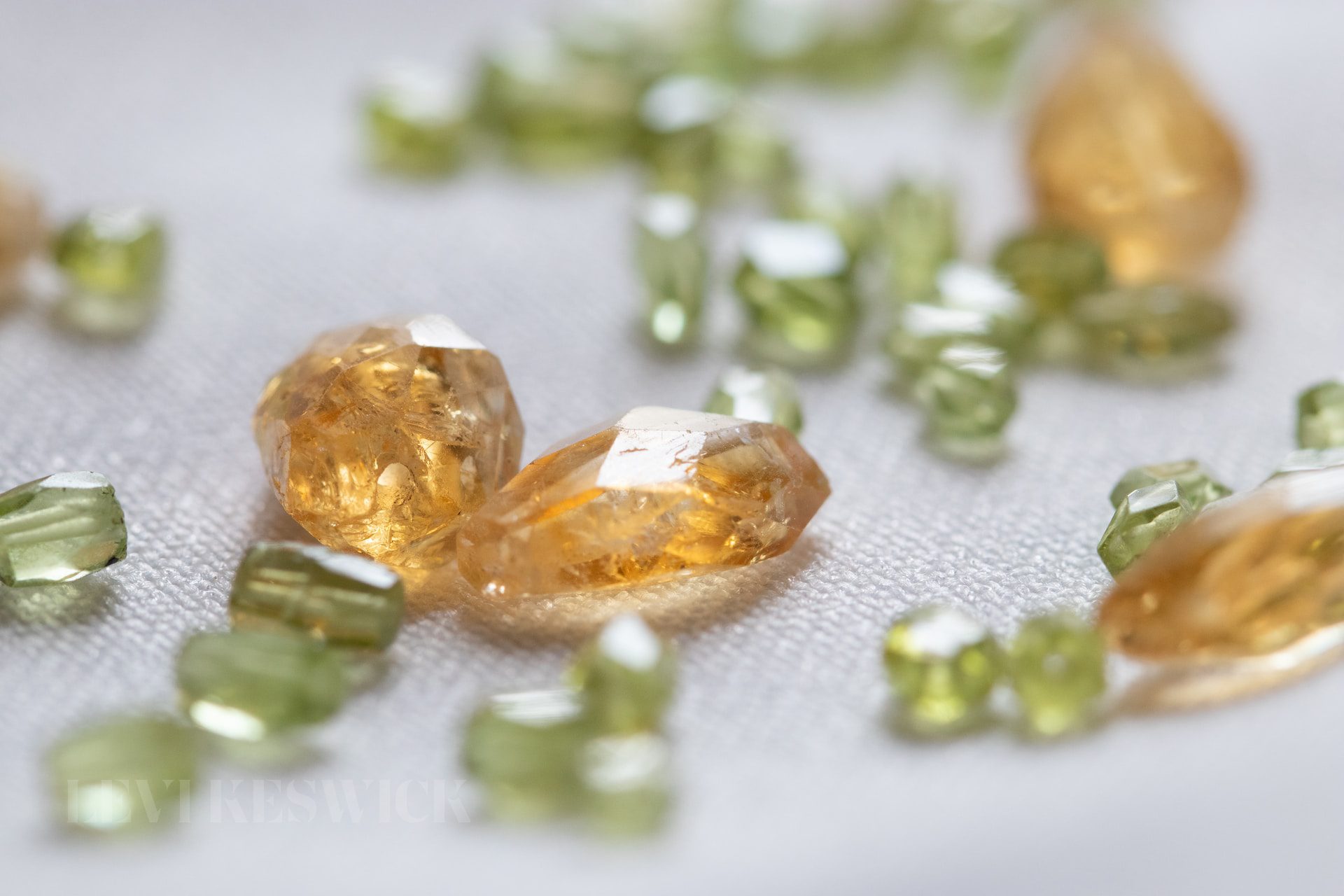Key Takeaways
- Peridot, also known as olivine or chrysolite, is a gemstone-quality mineral found in a single color: olive green.
- The green hue is derived from trace amounts of nickel, with some stones showing a reddish tint due to iron oxidation.
- Peridot has a Mohs scale hardness of 6.5-7, making it a relatively durable gemstone.
- While olivine is abundant in the earth, gem-quality peridot is quite rare, classifying it as a precious gemstone.
- Peridot has been found not only on Earth but also in meteorites, the Moon, Mars, and the dust of comets and asteroids.
The Origins and Composition of Olive Green Gemstones: Peridot
Peridot, a gemstone known for its captivating olive green hue, is the gemstone-quality variant of the mineral olivine. This unique mineral is primarily composed of magnesium, iron, oxygen, and silicon, with trace amounts of manganese and nickel occasionally present. The olive green color, which is the defining characteristic of peridot, is attributed to the presence of nickel, although some stones may display a slight reddish tint due to iron oxidation.
Unraveling the Mysteries of Peridot’s Unique Color
The term “peridot” itself is derived from the French word for olivine, and it is one of the few gemstones that appears in only one color. This exclusivity makes the olive green gemstones particularly intriguing and valuable. The intensity of the green hue in peridot can vary, with some stones appearing more yellowish-green and others exhibiting a richer, more saturated olive green.
The Hardness and Durability of Peridot
Peridot’s durability is measured using the Mohs scale of mineral hardness. With a rating of 6.5-7, peridot is a relatively durable gemstone, falling between quartz (7) and orthoclase feldspar (6). This hardness makes peridot suitable for use in various types of jewelry, including rings, earrings, and necklaces.
The Rarity and Precious Status of Peridot
Though olivine is abundant within the Earth’s mantle, gem-quality peridot is quite rare. This scarcity elevates peridot to the status of a precious gemstone, as opposed to semi-precious gems such as topaz or citrine. Some of the highest-quality peridot gemstones have been sourced from Zabargad Island in the Red Sea, while other notable sources include Myanmar, Pakistan, and the United States.
Peridot Beyond Earth: A Cosmic Connection
One of the most fascinating aspects of peridot is its presence beyond our planet. This olive green gemstone has been discovered in meteorites, the lunar surface, Mars, and the dust of various comets and asteroids. This cosmic connection highlights the universality of the elements that make up our world and adds an otherworldly allure to the beauty of peridot.
The Timeless Appeal of Olive Green Gemstones in Jewelry
Owing to its captivating color and relative durability, peridot has long been a popular choice for use in jewelry. The olive green gemstone’s unique hue pairs well with various metals, including gold, silver, and platinum. Peridot’s versatility makes it an excellent choice for rings, earrings, necklaces, and bracelets, adding a touch of elegance and sophistication to any ensemble.
The allure of olive green gemstones, particularly peridot, lies in their singular color, rarity, and cosmic connections. Whether you’re a gemstone enthusiast or simply someone who appreciates the beauty of unique jewelry, the olive green peridot offers a stunning and valuable addition to any collection. With its fascinating history and rare presence both on Earth and in the cosmos, peridot’s allure is truly unmatched, making it an extraordinary gemstone worth cherishing.
The Symbolism and Lore of Peridot
Throughout history, peridot has held a special significance in various cultures, with many attributing unique symbolism and lore to the olive green gemstone. In ancient Egypt, peridot was known as the “gem of the sun” and was believed to protect its wearer from the terrors of the night. It was also said to bring happiness, prosperity, and good fortune to those who possessed it.
In medieval Europe, peridot was valued for its perceived ability to alleviate depression, promote sleep, and ward off evil spirits. Additionally, it was believed that wearing peridot could enhance the power of medicinal herbs and attract love.
Today, peridot is known as the birthstone for August, symbolizing strength, vitality, and prosperity. Its vibrant olive green hue is said to promote growth, renewal, and a sense of calm, making it a popular choice for those seeking balance and harmony in their lives.
Caring for Your Olive Green Gemstones: Tips for Peridot Maintenance
To maintain the beauty and longevity of your peridot jewelry, it is essential to care for your olive green gemstones properly. Here are some tips to help you keep your peridot looking its best:
- Clean your peridot with a soft, damp cloth and mild soap, avoiding harsh chemicals and abrasive materials.
- Store your peridot jewelry separately from other gemstones to prevent scratches and damage.
- Remove your peridot jewelry before engaging in activities that may expose it to harsh chemicals, extreme heat, or potential damage, such as swimming, gardening, or cooking.
- Have your peridot jewelry inspected by a professional jeweler regularly to ensure the settings and mountings are secure.
By following these simple guidelines, you can enjoy the beauty of your olive green gemstones for years to come.
Conclusion: The Enduring Charm of Peridot
Olive green gemstones, particularly peridot, have captivated the hearts and minds of gemstone enthusiasts and jewelry lovers for centuries. With its unique and mesmerizing color, precious status, and cosmic connections, peridot offers a rare and enchanting addition to any gemstone collection. Whether as a gift to celebrate an August birthday or a personal talisman symbolizing strength and growth, peridot jewelry is sure to enchant and inspire.








